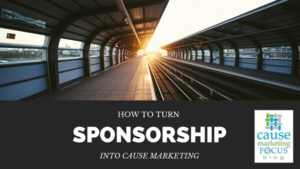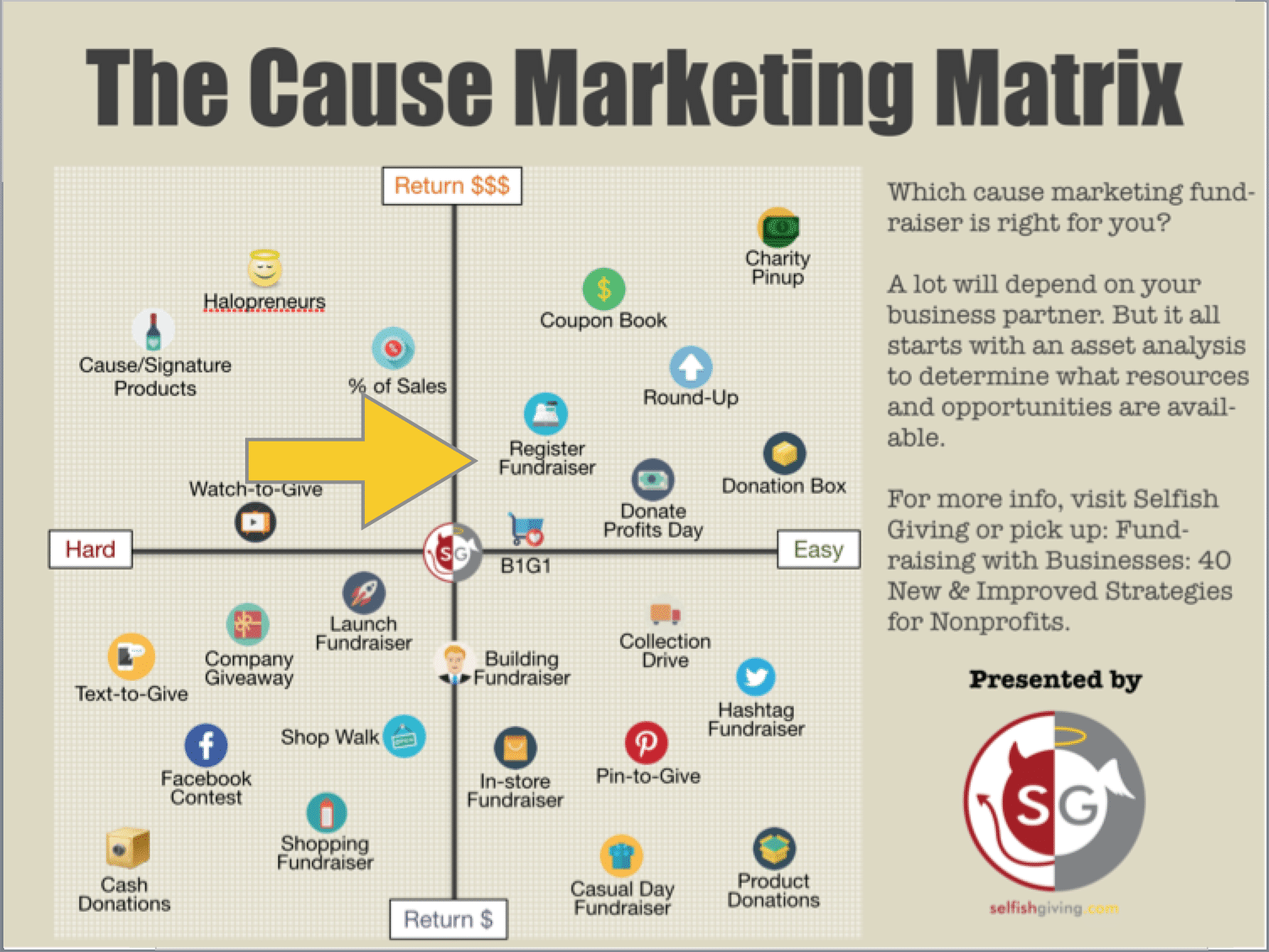 I get a lot of questions about how nonprofits can better solicit companies for sponsorships. I love to answer these inquiries because any organization with guts and smarts can raise money from win-win partnerships.
I get a lot of questions about how nonprofits can better solicit companies for sponsorships. I love to answer these inquiries because any organization with guts and smarts can raise money from win-win partnerships.
After I answer all of a nonprofit’s questions, I always follow up with, “Would you like to learn about another way to raise money from companies, a way that raises a lot more money than sponsorship ever could?”
I’ve got their attention. Here’s what comes next.
THE DIFFERENCE BETWEEN SPONSORSHIP AND CAUSE MARKETING
Sponsorship is very straightforward. In exchange for cash or product, the company gets promotion through the nonprofit’s events and/or programs that may lead to increased sales for the company (that’s often the goal anyway).
 If a company sponsors a walk, they get promotion at the walk, their name on a banner or on a walk t-shirt and likely a few other benefits.
If a company sponsors a walk, they get promotion at the walk, their name on a banner or on a walk t-shirt and likely a few other benefits.
The challenge with sponsorship is that the pool of money most companies allot for it is fairly small. Companies are cutting back on sponsorship–especially for nonprofits–and are more aware than ever that benefits like a banner at a cause walk have limited marketing value.
Cause marketing differs from sponsorship in that a company turns its customers and employees into fundraisers for your nonprofit.
For example, instead of writing a small check to sponsor a cause walk, a supermarket chain will ask customers to donate a buck or two at the register. (There are many other fundraising options than register programs. Find 39 additional fundraising ideas here. Also, check out my Pinterest boards.)
Cause marketing is better than sponsorship for a couple of reasons.
First, there’s more money in the customer and employee than there is the company checkbook. As I said earlier, company sponsorship dollars are limited. But with cause marketing you’re only limited by the number of employees and customers the business can access.
For example, Lowe’s home improvement stores offer more than 15 million customer interactions a week. Would you rather get money from one company checkbook or tap the wallets of 15 million customers? Before you answer, you might want to ask the Muscular Dystrophy Association what they think. Since 2001, MDA has raised $50 million from Lowe’s customers.
Second, the benefits of cause marketing are greater for the business partner. Sure, Lowe’s could sponsor MDA’s walk, but what’s the reach of the walk compared to bringing the charity in store for all to see? Lowe’s can raise more money by involving customers and employees. Lowe’s also has more control over the message and visibility tied to its efforts.
Sponsorship has its place for nonprofit, for-profit partnerships, but if you want to raise more money and gain more visibility both for the business and the nonprofit, cause marketing wins hands down. As a fundraiser, cause marketing is sponsorship on steroids!
HOW TO TURN SPONSORSHIPS INTO CAUSE MARKETING PARTNERSHIPS
First, research your current corporate partners. Which of your partners are:
- Business-to-consumer (retailers, restaurants, supermarkets, etc.)
- Have lots of foot traffic (busy stores with bustling aisles and long lines)
- Have lots of locations (the more, the better)
These businesses are your best candidates for cause marketing and its most lucrative tactics, which I call point-of-sale (the upper right quadrant of the Cause Marketing Fundraiser Matrix).

Second, try to build on what you already have. People get nervous when I talk about converting sponsors into cause marketing partners because they don’t want to lose a guaranteed check.
What if cause marketing doesn’t work out?
Fortunately, I’m not asking you to give up anything. Ask sponsors to support your nonprofit with a pilot cause marketing program so you can both review the results. Of course, a nonprofit may eventually have to choose between a $10,000 sponsorship and a $100,000 cause marketing program. Assuming you can do basic math, I’m confident you’ll make the right choice!
Third, use cause marketing dollars to underwrite sponsorships. I had a conversation the other day with a retailer that was raising over a million dollars for a health organization, yet none of those dollars were being earmarked for sponsorships at the charity’s many events across North America. The nonprofit bristled at the suggestion that cause marketing should underwrite sponsorships!
Businesses that choose cause marketing programs over sponsorships can and should be rewarded with sponsorships at nonprofit events and programs. Not only is this a powerful way to entice businesses to give cause marketing a try, it generally costs the nonprofit nothing to include a company on a walk t-shirt or in a gala program book.
But perhaps there is some small expense that the nonprofit has to incur. What should a business partner do? The answer is a simple one for me.
If a nonprofit is balking on paying for a $500 event banner after a company has raised $100,000 with a cause marketing fundraiser, the company should take its sponsorship, cause marketing and its money elsewhere.
